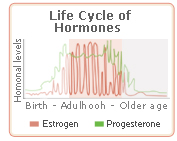Soy and Menopause
 When a women approaches menopause her body goes through many changes and her hormone levels begin to fluctuate. Estrogen levels drop resulting in the onset of many uncomfortable menopausal symptoms. To ease these symptoms, many women rely on soy. With its estrogen like properties it can help balance out hormones in menopausal women. When a women approaches menopause her body goes through many changes and her hormone levels begin to fluctuate. Estrogen levels drop resulting in the onset of many uncomfortable menopausal symptoms. To ease these symptoms, many women rely on soy. With its estrogen like properties it can help balance out hormones in menopausal women.
Continue reading below to learn more about menopause and soy.
Soy for Menopausal Women
 Fluctuating levels of estrogen can cause hot flashes, night sweats, vaginal dryness, insomnia and headaches. The list goes on and on. In recent times, women have undergone hormone replacement therapy (HRT) to ease such menopausal symptoms. HRT however has negative side effects and can be very expensive. For many nutritionists, menopause and soy go hand-in-hand. They suggest soy for menopause as soy treatment can ease symptoms by raising estrogen levels, without the negative side effects of HRT. Fluctuating levels of estrogen can cause hot flashes, night sweats, vaginal dryness, insomnia and headaches. The list goes on and on. In recent times, women have undergone hormone replacement therapy (HRT) to ease such menopausal symptoms. HRT however has negative side effects and can be very expensive. For many nutritionists, menopause and soy go hand-in-hand. They suggest soy for menopause as soy treatment can ease symptoms by raising estrogen levels, without the negative side effects of HRT.
For menopausal women who produce little estrogen, soy can be very helpful. Soy's phytoestrogens can produce estrogenic activity that may relieve symptoms of menopause.
Isoflavones for Menopause
Soy contains phytoestrogens in the form of isoflavones. Phytoestrogens are plant-derived compounds that can behave like estrogen in the body when consumed by humans. Isoflavones make up a class of organic compounds that have beneficial health properties. These include:
. Antioxidants properties.
. Preventing fractures.
. Easing symptoms of menopause.
. Easing symptoms of diabetes.
. Potentially warding off disease such as cancer, psoriasis, and osteoporosis.
Sources of Soy
Soy is the best source of isoflavones. Listed below are some foods that contain soy.
 . Soybeans. . Soybeans.
. Tofu.
. Tempeh.
. Soymilk.
. Soy flour.
Effectiveness of Soy for Menopause
 Despite evidence that women who consume soy experiences less menopausal symptoms, studies are ongoing to determine whether isoflavones function similar to estrogen to decrease menopausal symptoms. For this reason, many turn to other herbs that do not contain phytoestrogen. Non-etrogenic herbs are free from estrogen like properties and often have fewer side effects. Despite evidence that women who consume soy experiences less menopausal symptoms, studies are ongoing to determine whether isoflavones function similar to estrogen to decrease menopausal symptoms. For this reason, many turn to other herbs that do not contain phytoestrogen. Non-etrogenic herbs are free from estrogen like properties and often have fewer side effects.
Which herb should women try? Today women are looking for relief from their menopause symptoms with herbs. Phytoestrogenic herbs and non-estrogenic herbs are good in relieving menopause symptoms, but recent studies show that non-estrogenic herbs have no side effects because they help the body to produce its own hormones instead of introducing hormones like the phytoestrogenic ones. Learn more about non-estrogenic herbs for menopause.
| 

